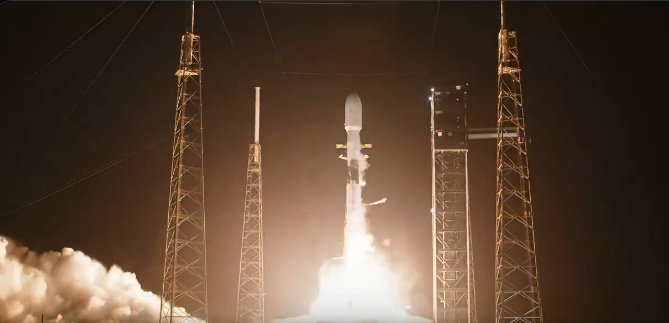SpaceX has once again demonstrated its mastery of orbital launches and booster recovery with the successful deployment of 24 Amazon Project Kuiper satellites and the flawless landing of a brand-new Falcon 9 first stage.
The mission, officially designated Kuiper Falcon 1 (KF‑01), lifted off from Cape Canaveral Space Launch Complex 40 (SLC‑40) at 2:30 a.m. EDT (06:30 UTC). Clear skies and calm conditions, with an 80% probability of favorable weather, set the stage for a smooth countdown and liftoff.
Liftoff! pic.twitter.com/3lB7Zz4S2b
— SpaceX (@SpaceX) July 16, 2025
The payload consisted of 24 broadband internet satellites for Amazon’s Project Kuiper, a developing low Earth orbit (LEO) satellite constellation designed to provide global internet coverage and compete directly with SpaceX’s own Starlink network.
This was a critical step in Amazon’s effort to begin building out its orbital infrastructure. With today’s successful delivery, the total number of Kuiper satellites launched by SpaceX stands at 106, marking the third operational batch under the current partnership between the two tech giants.
However, the mission’s spotlight wasn’t solely on the Kuiper satellites. Making its debut flight, the Falcon 9 booster B1096 performed flawlessly during ascent, stage separation, and its critical descent phase. Approximately 8.5 minutes after launch, B1096 executed a controlled descent and precision landing on SpaceX’s autonomous droneship A Shortfall of Gravitas (ASOG), stationed in the Atlantic Ocean.
The landing marks another notch in the company’s reusability milestone belt, as even first-flight boosters are now expected to return safely. SpaceX has turned what was once considered cutting-edge into a routine part of its operations, dramatically reducing launch costs and turnaround times.
This flight continues the remarkable consistency of Falcon 9’s recovery record, further proving SpaceX’s claim that booster reuse is not only possible but reliable. While veteran boosters have flown as many as 21 times, SpaceX remains committed to recovering even new stages to sustain its rapid launch cadence and long-term economics.
The satellite deployment occurred about an hour into the mission, with all 24 Kuiper spacecraft released into their planned orbits. Ground controllers later confirmed successful acquisition of signal from each satellite, marking full mission success.
Project Kuiper aims to deploy over 3,200 satellites over the coming years, with Amazon committing billions of dollars to the venture. The goal is to provide high-speed, low-latency internet access to underserved and remote areas across the globe. With competition from Starlink intensifying, Kuiper’s early launches are critical to establishing its orbital infrastructure and service roadmap.
Today’s launch was part of a broader agreement signed between Amazon and SpaceX earlier this year, which includes nine Falcon 9 launches to help deploy a substantial portion of the Kuiper constellation in the short term.
The booster recovery on ASOG also ensures that B1096 will likely see many more flights in the future. SpaceX typically inspects and refurbishes landed boosters in less than two months, setting the stage for its next mission. The success of B1096’s maiden voyage underscores the maturity of Falcon 9’s design, where first-time flights are executed with confidence and routine precision.
With a steady pipeline of missions ahead—including more Kuiper deployments, NASA crew launches, and Starlink batches—SpaceX continues to dominate the commercial launch landscape both in volume and reusability.
Mission Quick Facts:
-
Mission Name: Kuiper Falcon 1 (KF‑01)
-
Launch Date: July 16, 2025
-
Time: 02:30 a.m. EDT (06:30 UTC)
-
Launch Site: SLC‑40, Cape Canaveral Space Force Station
-
Payload: 24 Amazon Project Kuiper broadband satellites
-
Booster: Falcon 9 B1096 (maiden flight)
-
Landing: Successful on A Shortfall of Gravitas droneship
-
Orbit: Low Earth Orbit (LEO)
-
Weather Conditions: 80% favorable
As SpaceX celebrates another textbook mission, the race for orbital internet supremacy is heating up—and both rockets and rivals are now moving at full speed.








